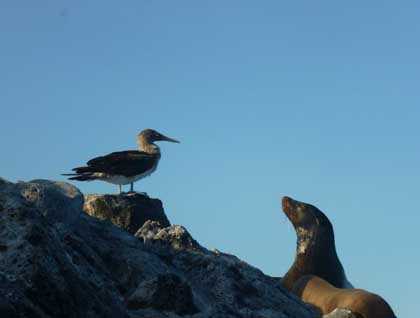Today we have calm sea conditions as we head out for an early morning walk at Punta Cormorant. Right at the landing spot, we have a small welcome committee of sea lions, while blue footed boobies perch on the cliffs of volcanic sand and tuff stone. The walk leads along a shallow salt water pond and through an incense tree forest, to a sea turtle nesting site. In the lagoon we spot a few flamingoes, resident to these islands. This time of the year, the female turtles start nesting, and we see about a dozen turtles in the light surf. Frigate birds are higher up riding the thermals.
And yet, after yesterdays’ visit, we notice that this island has a lot less wildlife.
Floreana is the island with the longest human presence in this archipelago, and therefore it has been the most affected. Currently, some 120 people live permanently on the island, and since it is a small island, their impact was, and is, relatively big. Feral cats, rats and a constant flow of day trippers and cargo to the small village introduce the risks of unwanted visitors like invasive species, either plants, microbes or insects. Because of the riches the day trippers bring, all residents now want more development.
In a sense, this island is coming upon a phase that another Galapagos island, called Santa Cruz, went through some thirty years ago, and this is why several NGOs have joined in a campaign called “Project Floreana”, where the goal is to not make the same mistakes as have been made in Santa Cruz, home to the largest human population in Galapagos. Project Floreana tastes of an idealism, one where man lives in harmony with nature, like the Romantics in the nineteenth century. In the eyes of the critics, it is the latest attempt to create a fairytale in the tradition of Robinson Crusoe.
If the project succeeds, the tide has been changed, and we will have an example to give to the world.
I hope for the latter.







